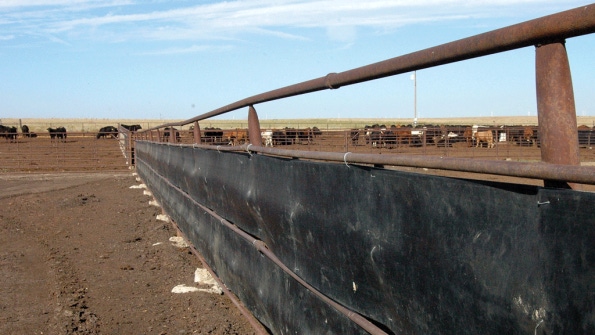Industrial conveyor belts protect cattle.
November 22, 2018

The proverbial “Blue Norther” is a virtual guarantee every winter for many High Plains producers. Some are just worse than others on cattle, and everything else.
With a wide-open backgrounding yard atop a hill on the rolling and treeless Texas Panhandle prairie, Dennis Hefley and son Nathan take no chances. By hanging used industrial conveyor belts along their pen fences, they protect yearlings from smothering, blowing snow and wind chills far below zero.
The Hefleys run stocker cattle year-round in the northeastern Panhandle, near Briscoe. “We buy sale barn cattle from eastern Oklahoma and South Texas,” says Dennis. “They are grazed on either bermuda or bluestem, and a little love grass.

Nathan (left) and Dennis Hefley use a novel weather shield.
“The Oklahoma cattle usually do good all year-round. But many of the South Texas cattle are thin-haired and don’t do as well in the winter if they’re exposed to harsh conditions,” he says.The Hefleys, lifelong residents of the region, decided to install the backgrounding yard three years ago. They built about 20 standard-sized pens, using typical oil field pipe as fencing. They converted irrigated wheat fields to sorghum silage production under center-pivot.
To make sure cattle would eat their fill in rough winter conditions, they sought the best ways to build windbreaks along the northern sides of the pens. “We ran across a company called Repurposed Materials, which had wide conveyor belts for sale,” Dennis says. “It was described as being very study, having been used in coal mines or other factories back East. We gave the belts a try and bought about 3,000 feet of belts ranging from 18 to 43 inches wide, and three-eighths of an inch thick.”
The belts arrived in large spools. They were cut into 90-foot lengths and holes drilled about every 8 feet Galvanized wire was threaded through the holes to secure the material to the top rail. Additional holes were drilled to enable the belts to be more firmly secured to the lower rails.
Nathan points out that a 43-inch-wide belt is very heavy. “It required several people to hang it,” he says. “The 18-inch-wide belts were easier to install, but we had to wire two or three strips per fence.”

While the repurposed conveyor belts were installed to provide wind protection, they also provide shade on hot, summer days.
Most of the windbreaks were installed in late fall of 2015 — and just in time. “We were lucky that we got the breaks put up before the ‘Christmas blizzard’ that hit the Panhandle,” Dennis says.The rash storm hit the region just after Christmas. It brought more than a foot of snow pushed by 40- to 50-mph winds. In the southwestern Panhandle, thousands of dairy cattle perished, as did many cattle in feedyards and backgrounding yards.
“That storm was forecast to come right through here, but the bulk of it missed us,” Dennis says. “But we still had a lot of snow and wind. Fortunately, the windbreaks provided protection for the cattle. We had no death losses.
“Natural windbreaks in our pastures protected cattle out on grass. We’re just glad we had the conveyor belts installed to provide shelter for cattle in the yard.”
Repurposed Materials, with warehouses in Denver and several other cities, obtains many types of previously used equipment from various industries. Items can be everything from conveyor belts, used truck tires and storage containers of all sizes, to military parachutes; various types of wire, cable and rope; plastic signage used on billboards; brushes from street cleaners (great for backscratchers) — you name it.
“We’re just an industrial thrift store,” says Damon Carson, founder and president of Repurposed Materials. “We are not recycling. We use byproducts and waste” that can get a second use in life.
Of course, producers have used discarded materials on the farm or ranch forever. How many remember burning trash in a 40-gallon barrel? Most silage pits still wouldn’t function without hundreds of tires being used to secure the plastic cover.
The Hefleys note that when buying “repurposed” material, you probably get what you pay for. “These belts are extremely sturdy and helpful to us. But they aren’t cheap,” Dennis says. “We paid about $500 for 90 feet of belt. That’s expensive, but it wound up being a lot more durable than putting up tin or guard rails.”
He says the windbreaks are helping promote better performance from cattle blessed with excellent grazing in 2016. “Cattle were in good shape when we placed them in the backgrounding yard for a ration of sorghum silage, corn gluten and bermuda hay,” Nathan says. “We’ve noticed on hot days, they get behind shade provided by the belts when they can.”
The Hefleys carry the repurposed angle as far as possible. “When we built the yard, we used concrete discarded by oil field processing crews,” Dennis says. “They dumped it on our place. It was crushed and made for a good surface for our roads.”
That, too, should come in handy when the next blizzard blasts through the region.
Larry Stalcup is a freelance writer based in Amarillo, Texas.
You May Also Like



